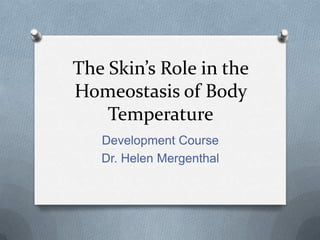Thermoregulation by the skin
•Transferir como PPTX, PDF•
0 gostou•109 visualizações
Denunciar
Compartilhar
Denunciar
Compartilhar

Recomendados
Recomendados
Mais conteúdo relacionado
Semelhante a Thermoregulation by the skin
Semelhante a Thermoregulation by the skin (20)
Role of hypothalamus in regulation of body temperature

Role of hypothalamus in regulation of body temperature
Body temperature by Pandian M, Tutor Dept of Physiology, DYPMCKOP, this PPT f...

Body temperature by Pandian M, Tutor Dept of Physiology, DYPMCKOP, this PPT f...
Ths general biology unit 3 cell processes homeostasis and feedback mechanisms...

Ths general biology unit 3 cell processes homeostasis and feedback mechanisms...
Temperature practical cum theory part by Pandian M, From DYPMCKOP. This PPT f...

Temperature practical cum theory part by Pandian M, From DYPMCKOP. This PPT f...
Homeostasis and Feedback, Elshennawy, 1444-2023.pptx

Homeostasis and Feedback, Elshennawy, 1444-2023.pptx
Thermoregulation by the skin
- 1. The Skin’s Role in the Homeostasis of Body Temperature Development Course Dr. Helen Mergenthal
- 2. HOMEOSTASIS • Internal conditions are not absolute • Limited range • Vary around a set point
- 3. Negative feedback is when the body senses a change and tries to reverse it back to stability.
- 4. Feedback Loops consists of: • Homeostatic range for a variable • Receptors • Control center • Effector
- 5. • Homeostatic range: 37 degrees Centigrade or 98.6 degrees Fahrenheit (plus or minus 0.5 degrees) • The body’s thermostat is a part of the brain called the Hypothalamus. • Above 37.5 degrees Centigrade, homeostasis is disturbed.
- 6. OpenStax College. (2013, June 19). Anatomy & Physiology. Retrieved from the Connexions Web site: http://cnx.org/content/col11496/1.6/
- 7. If the body temperature goes below 36.5 degrees Centigrade (97.7 degrees Fahrenheit) • Blood vessels in skin constrict • Sweat glands stay inactive • Shivering, involuntary muscle contractions, releases heat
Notas do Editor
- OpenStax College. (2013, June 19). Anatomy & Physiology. Retrieved from the Connexions Web site: http://cnx.org/content/col11496/1.6/